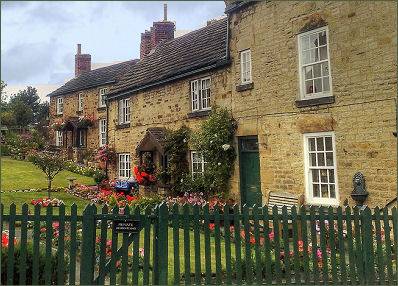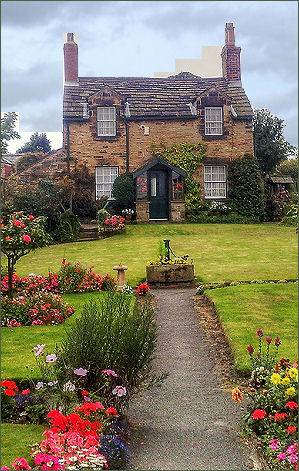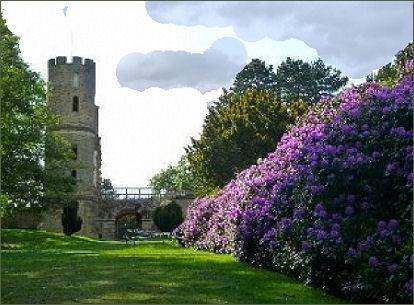Wentworth
OS Grid reference- SK 385 985
 The picture postcard village of Wentworth near Rotheram, perhaps the prettiest village in South Yorkshire, lies around 3 mles to the south of Barnsley.
The picture postcard village of Wentworth near Rotheram, perhaps the prettiest village in South Yorkshire, lies around 3 mles to the south of Barnsley.
 The village boasts attractive cottages and houses of architectural and historic interest. The site of the village stocks in Main Street is now occupied by a telephone kiosk; opposite is the base of the village cross. The estate cottages along Main Street were built from the early seventeenth century onwards. The oldest known cottage, Ivy Cottage, a cruck cottage, is attached to Snowdrop Farm.
The village boasts attractive cottages and houses of architectural and historic interest. The site of the village stocks in Main Street is now occupied by a telephone kiosk; opposite is the base of the village cross. The estate cottages along Main Street were built from the early seventeenth century onwards. The oldest known cottage, Ivy Cottage, a cruck cottage, is attached to Snowdrop Farm.
The Old Holy Trinity Church is believed to date back to the twelfth century, the aslar sandstone tower dates from the fourteenth – fifteenth century. It was extended in 1684 by the 2nd Earl of Strafford in memory of his wife, Henrietta Stanley, whose initials can be found throughout the chancel. Lady Henrietta's memorial is set upon the wall. In 1925 the chancel and a chapel were restored for William Wentworth-Fitzwilliam, 7th Earl Fitzwilliam. Further renovation was carried out in 1985. The church is now redudant and is maintained by the Redundant Churches Fund.
The chancel and chapel are still in occasional use. The building contains monuments to various generations of the Wentworth family including Thomas Wentworth (1587), William Wentworth (1614), Thomas Wentworth (1641) and William Wentworth (1685). The most famous Wentworth represented is probably Thomas, the Earl of Strafford (died. 1641). The Earl was an advisor to King Charles I and a major figure in the period leading up to the English Civil War. He paid for his support of the king by losing his life when the king abandoned him and he was executed for treason by beheading on Tower Hill in 1641.
The new church, Holy Trinity Parish Church, was commissioned in 1872 by the 6th Earl Fitzwilliam.
The major landmark is Wentworth Woodhouse country house. No less than 21 follies stand in the grounds including the Needle's Eye, Hoober Stand, Keppel's Column, the Mausoleum, the Ionic Temple and Doric Temple, the Vinegar Stone, and the Bean Seat. Close to Hoober Stand is the Hoober Observatory of the Mexborough & Swinton Astronomical Society. The Wentworth Brewery is based in the old power house.
 Wentworth is of ancient origin and is mentioned in the Domesday Survey of 1086, when Rynold Wynterwade was recorded as
lord of the manor. The history of Wentworth village is inextricably linked with the history of the great aristocratic families, the Wentworths, Watsons and Fitzwilliams who presided over it for generations. In around 1250 Robert Wentworth married Emma Woodhouse, beginning the Wentworth-Woodhouse line, the family lived in the area for over 450 years.
Wentworth is of ancient origin and is mentioned in the Domesday Survey of 1086, when Rynold Wynterwade was recorded as
lord of the manor. The history of Wentworth village is inextricably linked with the history of the great aristocratic families, the Wentworths, Watsons and Fitzwilliams who presided over it for generations. In around 1250 Robert Wentworth married Emma Woodhouse, beginning the Wentworth-Woodhouse line, the family lived in the area for over 450 years.
When William Wentworth, 2nd Earl of Strafford died without issue the lands passed to Watson family who held it until 1782. The Wentworth, Watson-Wentworth and Wentworth-Fitzwilliam families lived in Wentworth Woodhouse. They also owned most of the land in the village.
During this time most of the local follies were built. The Fitzwilliam ownership ended in 1979 with the death of William Thomas George Wentworth-Fitzwilliam, 10th Earl Fitzwilliam. The Fitzwilliam's ownership resumed when the title, Earl Fitzwilliam, was created for a second time in 2015 and Lady Juliet Tadgell became Countess Fitzwilliam.
Nearby Tankersley Manor is a former manor house which dates, in parts, to the seventeenth century.
